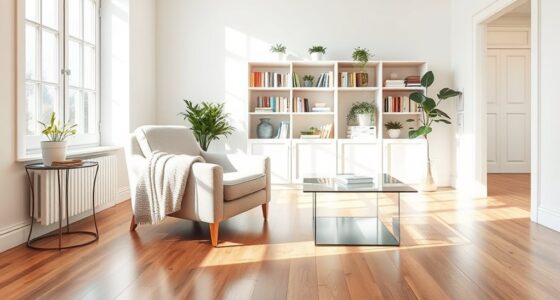Maintaining your indoor humidity between 40% and 60% creates the ideal environment for comfort, health, and durability. When humidity levels stay within this range, you’ll enjoy better air circulation, fewer mold issues, and less static electricity. Too high, and your space may feel damp and promote mold growth; too low, and it can cause dryness and irritation. Staying within the 40–60% range supports a healthier, more comfortable home—if you want to learn more, keep going.
Key Takeaways
- The 40–60% humidity range balances comfort, air quality, and mold prevention indoors.
- Maintaining this range improves air circulation and reduces stagnant, stale air.
- Humidity within 40–60% minimizes mold growth and structural damage.
- Proper humidity supports health by reducing skin and respiratory irritations.
- Using humidifiers or dehumidifiers helps keep indoor moisture levels within this optimal range.

Have you ever wondered why your comfort level fluctuates with the humidity in the air? It’s because humidity directly impacts how you feel, how your home’s air circulates, and even how healthy your environment remains. The key is finding that perfect humidity range—usually between 40% and 60%—that experts call the “humidity sweet spot.” Staying within this range isn’t just about comfort; it’s also crucial for air circulation and mold prevention.
When humidity levels are too high, say above 60%, you might notice your home feels damp or sticky. This excess moisture hampers proper air circulation because humid air tends to stagnate, making it harder for fresh air to flow freely through your space. Poor air circulation can lead to stale smells, uneven temperatures, and a buildup of indoor pollutants. More importantly, high humidity creates an ideal environment for mold growth, which can cause health issues and damage to your home. Mold loves moist environments, and when humidity stays above 60%, it can start to colonize on walls, ceilings, and even furniture, causing costly damage and health risks.
On the flip side, if the humidity drops below 40%, the air becomes dry, which can also cause discomfort. Dry air can irritate your skin, throat, and respiratory system, making you more susceptible to colds and respiratory infections. Plus, low humidity can impair your home’s air circulation by causing static electricity and making the air feel thin and stale. This dryness can also lead to the cracking of wooden furniture and paint, which isn’t just a cosmetic issue but can also impact your home’s structural integrity over time.
Maintaining the humidity within the 40-60% range helps promote ideal air circulation, ensuring your indoor environment remains fresh and healthy. Proper air circulation disperses pollutants, reduces moisture buildup, and prevents mold from settling in. Using humidifiers or dehumidifiers can help you fine-tune your home’s humidity level, especially during seasonal changes when outdoor air moisture fluctuates sharply. Regularly monitoring your indoor humidity with a hygrometer gives you real-time insight, so you can adjust your devices accordingly. Controlling indoor moisture is essential for maintaining a healthy living space.
In essence, sticking to this humidity sweet spot isn’t just about feeling comfortable; it’s about creating a healthier, safer environment. Good air circulation and mold prevention go hand-in-hand with maintaining the right humidity level. By keeping your home within that 40-60% window, you ensure better air quality, protect your belongings, and enjoy a more consistent, pleasant living space. It’s a simple adjustment that offers significant benefits, making your home a more comfortable and healthier place to be.
Frequently Asked Questions
How Does Humidity Affect Indoor Air Quality?
You might notice that humidity levels directly impact your indoor air quality. When humidity is too high, mold growth and dust mites thrive, worsening allergies and respiratory issues. Conversely, too low humidity can cause dry skin and irritate your throat. Maintaining humidity between 40-60% helps control mold and dust mites, creating a healthier environment. Keep an eye on your levels to guarantee ideal air quality and comfort in your home.
Can Humidity Levels Impact Allergy Symptoms?
Some might think humidity doesn’t influence allergies, but it actually does. When your indoor humidity is too high or low, it can worsen allergy symptoms by increasing allergy triggers like dust mites and mold growth. Maintaining humidity levels within the 40–60% range helps control these triggers, reducing your allergy symptoms. Proper humidity management creates a healthier environment, making breathing easier and lessening allergy-related discomfort.
What Tools Are Best for Measuring Indoor Humidity?
To measure indoor humidity accurately, you should use a reliable hygrometer or smart humidity monitor. Make certain to regularly calibrate your hygrometer to guarantee precise readings, especially if it’s a mechanical device. Smart monitors often come with calibration features and app integration, making it easier to track humidity levels over time. This helps you maintain ideal indoor conditions and reduce allergy symptoms caused by humidity fluctuations.
Does Humidity Influence Energy Consumption in Homes?
Humidity levels directly impact your home’s energy consumption. When humidity isn’t properly regulated, your heating or cooling system works harder, reducing energy efficiency. Maintaining ideal humidity, ideally between 40-60%, helps your HVAC operate smoothly, saving energy and lowering bills. So, by monitoring and adjusting humidity, you can improve comfort and make your home more energy-efficient, ensuring you’re not wasting energy on unnecessary temperature regulation.
How Can Humidity Control Benefit Plants Indoors?
Controlling humidity indoors benefits your plants by optimizing plant growth and preventing pests. When humidity stays within the ideal range, plants absorb moisture better, resulting in healthier leaves and stronger stems. Plus, maintaining proper humidity discourages pests like spider mites and mold, which thrive in overly dry or damp conditions. Keep humidity balanced to create a thriving environment that boosts growth and keeps pests at bay, ensuring your plants stay vibrant and healthy.
Conclusion
Now that you know the 40–60% humidity range is the key to comfort and health, imagine what might happen if you ignore it. Could subtle changes in your environment quietly affect your wellbeing or energy levels? The sweet spot isn’t just a number; it’s a secret to revealing better living. Keep this range in mind, and stay vigilant—you never know when the perfect humidity might be just around the corner, waiting to change everything.









